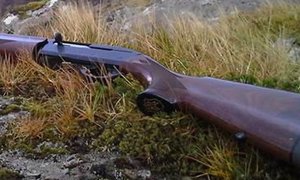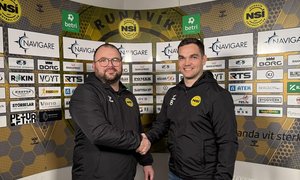Jeremy Cresswell
There can no longer be any doubt about the success of this year?s pioneering offshore drilling campaign, thanks to the determination of Amerada Hess and other members of the Faroes Consortium (BG, DONG and Atlantic Petroleum) that successfully pushed the lucky Marjun Prospect wildcat well to a much greater depth than was originally planned.
With one clear discovery notched up out of three exploration wells drilled, the success rate achieved in the first |Faroes campaign is smack on the global average. The trick now is to multiply that success several times over during the next two to three years, convert the discoveries into commercial projects and guarantee the islands a place among the world?s oil and gas nations.
Quite how this will be achieved is a question that will occupy many minds this winter as oil company geologists and others closely analyse the results of the three-well programme just completed.
The conclusions drawn will be critical to the intended 2002 schedule, not least because they will significantly influence where the next tranche of wells are drilled. With three ticked off so far, there are another five commitment wells to drill under the four six-year licences awarded in the First Faroe Islands Offshore Licensing Round announced in August 2000.
However, while we know that one of the three wells drilled this year was successful, the amount of public domain information about the early drilling results achieved by Amerada Hess, BP and Statoil, the first operators to drill the Faroe Islands Continental Shelf, remains sketchy. As expected, all focused on an area of the Faroe-Shetland Channel adjacent to the BP-operated Foinaven and Schiehallion oilfields in the UK sector.
It was Statoil that drilled the first well and, while it is regarded as a dry hole, traces of hydrocarbons were found. Likewise, BP?s well was declared dry, albeit it too produced evidence of oil and gas. And then it was third time lucky ... for Amerada Hess.
All three wells were drilled in the Judd Basin, which is a proven hydrocarbon province that has so far delivered the UK sector commercial discoveries Foinaven and Schiehallion.
Statoil?s Longan well (6005/15-1) was drilled this summer in licence area 003, 130km southeast of Faroes to a total depth of 4000m, terminating in Paleocene sediments.
Rolf Magne Larsen, who is in charge of the Norwegian company?s international exploration and production programme, was reported to be disappointed, though he said that data obtained would be useful while planning Statoil?s next commitment well.
Faroese petroleum minister, Eydun Elttur, said of the first result: ?Obviously it is disappointing that Statoil did not find commercial oil. However, identifying traces of hydrocarbons in the first well must be considered encouraging for future work in the area.?
Stakeholders in the Longan well are operator Statoil (35%); Phillips Petroleum (30%), Enterprise Oil (20%) and Veba Oil & Gas (15%). The rig used was the big semi-submersible Sovereign Explorer.
Next off the starting blocks was BP (66.67%), partnered by Shell (33.33%) and working with the super-drillship West Navion. Drilling of well 6004/12-1 started on July 23, some 27km to the northwest of the UK sector Suilven discovery, and was eventually completed on September 19. The well was taken to a total depth of 4,354 metres, again in the Paleocene, and was side-tracked.
Again, it fell to Elttur to break the apparently disappointing news.
?Once again we have to state that the drilling operation did not yield the expected result. The Svinoy exploration well penetrated the objective targets and demonstrated the presence of both oil and gas, although of non-commercial quantities at this location,? he said in a statement.
?Establishing that the Faroe Shelf holds a working petroleum system is however positive and considerably improves our expectations to finding oil in commercial quantities in the future.?
As for the Amerada Hess-operated 6004/16a-1 Marjun prospect wildcat well, there had been speculation for several days that the big semi-submersible Sovereign Explorer was on to something good. The bets were on gas with condensate or gas with oil. In the event, Minister Elttur announced the good news ? it was gas and oil encountered over a gross payzone of 170 metres. However, the well, which was drilled to a total depth of 4246m in 950m of water instead of just 3800m as originally intended, was not tested owing to poor weather conditions.
A cautious Elttur said: ?The success of this well is very important for the Faroe Islands as a future oil province, even if we do not at this moment of time know whether the find is commercial. Challenging tasks lie ahead for all license holders on the Faroe Shelf ...?
What the Marjun find achieved more than anything else was to remove all doubt about the existence of a potentially viable petroleum system beneath at least part of the basalt rock layer that has made assessing the Faroese sector so difficult
It is common for traces of hydrocarbons to be found when drilling exploration wells, but that does not mean conditions are anywhere near right for oil or gas to accumulate, hence the note of disappointment in Elttur?s announcements about the BP and Statoil wells. But an immense amount of valuable information was obtained from both ? the kind of data that could make a real difference to the next year?s campaign by other consortia, including the Agip and Foroya Kolvetni (FK) partnership.
This is a particularly important time for FK in that, though it is largely owned by Faroese, the company is expected to float on the London Stock Exchange early next year in a bid to raise £10-20million to finance its participation in the great, slow-pace Faroese oil race.
?We?re ready to go ? waiting for the right time to do it (float),? said FK?s chairman Graham Stewart. ?We?ve decided to wait until the New Year, most likely first quarter.?
Stewart is also finance director of Aberdeen-headquartered Dana Petroleum, which holds an option over 20% of FK?s shares and as a strategic partner
Had FK been floated on the LSE as an oil junior ahead of the first drilling campaign, it is possible that its share price would have suffered because of the Statoil and BP disappointments, but then picked up with the Amerada Hess news. Subject to a wholesale collapse in the price of oil this winter, it looks as if FK can look forward to a favourable reception when its shares begin trading ahead of the second drilling campaign.
FK and Agip?s two licences - 002 and 005 - span 11 part blocks and the Faroese company has the right to increase its holding to 22% before drilling starts next summer, armed with fresh 3D seismic survey data and information gleaned from this year?s pioneer wells.
However, it has been a long haul to get even to the current position. Until this summer, the only known traces of hydrocarbons in the Faroes area were found on land and comprise coal deposits, organic waxes found in basalt, and inconclusive traces of oil mixed with water in the Lopra-1 experimental well drilled in the early 1980s.
Geological mapping of the islands started in 1938 and, among the very earliest surveys known to have been carried out offshore by oil companies, is a little-known seismic campaign by Texaco in the mid 1970s. It is understood some 5,000km of seismic data was acquired, but which proved difficult to read, in part because of the limited capabilities of the 2-D seismic equipment used and due to the basalt layer that is characteristic of the Faroes Shelf.
An offshore borehole was, however, drilled under the Ocean Drilling Programme in the mid-1970s, though this was for scientific purposes and not a quest for hydrocarbons.
The Texaco/ODP work took place before the huge but complex and difficult Clair field was found on the UK side of the Faroe-Shetland Channel in 1977. While that event went unnoticed by the average Faroese, it registered in the corridors of power, both in Thorshavn and Denmark, which still rules the islands.
Information about events from the Clair find through to the ?90s is almost non-existent. There are not even references to the period in the 1993 Report of the Faroese Hydrocarbon Planning Commission to the Faroese Government. However, Arni Olafsson, for many years special adviser on Faroe Islands Affairs at the Danish Ministry of Foreign Affairs and member of the Faroese Hydrocarbon Planning Commission in 1993, provides a clue as to how events were being watched at the time.
Referring to the decision by Copenhagen in 1992 to cede mineral resources rights to the Faroese Home Rule government, Olafsson told the first Robert Gordon University/Smith Rea Energy Analysts Conference in Aberdeen (October 1994) that it ?came as a rather sudden political culmination of 17 years of difficult negotiations between Thorshavn and Copenhagen?.
On September 11, 1992 came the milestone event the Faroese had been awaiting for some time ... the decision by Denmark to surrender all rights to ?minerals in the subsoil? to Faroese control, and therefore the right to determine the course of the possible future oil and gas extraction industry.
In December 1992, the Faroese Hydrocarbon Planning Commission comprising Faroese and Danish experts in geology, ecology, petroleum administration, oil industry relations, economics and law was established to research and submit a report which would serve as the basis for initial policy decisions and to draft legislation necessary for the first stages of hydrocarbon development. That report and a draft Bill on preliminary seismic surveys, etc, were ready in June 1993.
The Government put the report and bill before the Logting and, that same year, on December 1, the decision was taken to form the Faroese Petroleum Administration (OFS). By this time, UK Atlantic Frontier (west of Shetland) successes had stoked up oil company interest in the Faroes.
In November 1993, OFS wrote to the oil companies, notifying the intention to commission seismic and gravimetric surveys. Bids were invited from survey companies and Western Geophysical secured both permits and ran 12,000km of survey lines.
World Geoscience conducted aerial surveys in 1995 and 1996. Also, in 1996, the Faroes sector was thrown open to all parties interested in conducting further seismic work, including re-entering and deepening the Lopra-1 well. It was on January 18, 1996 that a consortium of 19 oil companies led by DOPAS of Denmark won permission to re-enter the Lopra-1 well, which they duly did in July 1996.
February 15, 1996 saw the right to issue exploration licences transferred from the government to OFS and, by February 1, 1997, 10 preliminary licences were issued, the allocation of which was influenced by what the oil companies themselves had asked for. A total of 23 oil companies had submitted 13 nominations covering 108 whole and 26 part-blocks. 43 whole and 13 part-blocks were classified as ?very interesting?.
Then followed the long grind to get legislation finalised and onto the statute book, the decades-long boundary dispute with the UK settled, and the first licensing round launched. The last mentioned and, in practical terms, most critical event did not take place until February 1999.
Finally, OFS received 22 licence applications from 17 oil companies and, in August 2000, seven licences were awarded to 12 oil companies. Aside from the four six-year terms granted, three nine-year terms were also issued, with 005 going to Agip with FK; 006 handed to Statoil with Anadarko, Phillips, Enterprise and Veba; and 007 issued to Anadarko alone. Some 70% of the acreage originally offered to the companies was not awarded.
And so the hunt has begun in earnest. But a massive amount of effort over the next few years and some significant discoveries will be required before the long-held dream of the Faroe Islands becoming an oil and gas producing province in their own right can ever be realised, if that ever happens. However, it is far too early to know what the real potential is, though figures like 1 billion barrels of crude have been bandied about ? manna to the Faroese business community whose dream of cashing in on a mini-oil bonanza may no longer be as far-fetched as it once seemed.
Jeremy Cresswell is Editor in Chief at UK analysts EIS Energy Information Services.














